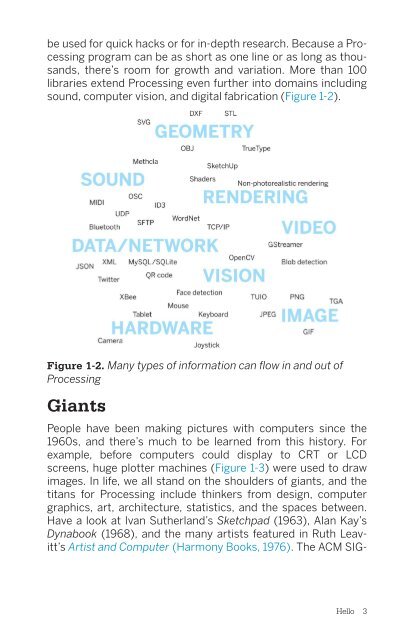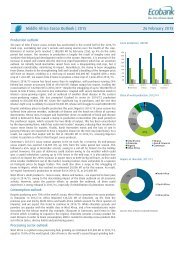- Page 1 and 2: www.ebook777.com
- Page 3 and 4: www.ebook777.com
- Page 5 and 6: www.ebook777.com Advance Praise for
- Page 7 and 8: www.ebook777.com Make: Getting Star
- Page 9 and 10: Example 3-11: Set Stroke Weight. .
- Page 11 and 12: 7/Media. . . . . . . . . . . . . .
- Page 13 and 14: 12/Data. . . . . . . . . . . . . .
- Page 15 and 16: Processing experienced a long child
- Page 17 and 18: that can be applied to creating gam
- Page 19 and 20: Maker Media, Inc. 1160 Battery Stre
- Page 21 and 22: Through founding the Aesthetics and
- Page 23: 2 Getting Started with Processing w
- Page 27 and 28: www.ebook777.com
- Page 29 and 30: 8 Getting Started with Processing w
- Page 31 and 32: 10 Getting Started with Processing
- Page 33 and 34: 12 Getting Started with Processing
- Page 35 and 36: 14 Getting Started with Processing
- Page 37 and 38: 16 Getting Started with Processing
- Page 39 and 40: 18 Getting Started with Processing
- Page 41 and 42: 20 Getting Started with Processing
- Page 43 and 44: 22 Getting Started with Processing
- Page 45 and 46: Figure 3-3. Colors are created by d
- Page 47 and 48: 26 Getting Started with Processing
- Page 49 and 50: 28 Getting Started with Processing
- Page 51 and 52: 30 Getting Started with Processing
- Page 53 and 54: 32 Getting Started with Processing
- Page 55 and 56: www.ebook777.com
- Page 57 and 58: 36 Getting Started with Processing
- Page 59 and 60: 38 Getting Started with Processing
- Page 61 and 62: 40 Getting Started with Processing
- Page 63 and 64: 42 Getting Started with Processing
- Page 65 and 66: 44 Getting Started with Processing
- Page 67 and 68: 46 Getting Started with Processing
- Page 69 and 70: 48 Getting Started with Processing
- Page 71 and 72: 50 Getting Started with Processing
- Page 73 and 74: 52 Getting Started with Processing
- Page 75 and 76:
54 Getting Started with Processing
- Page 77 and 78:
56 Getting Started with Processing
- Page 79 and 80:
58 Getting Started with Processing
- Page 81 and 82:
60 Getting Started with Processing
- Page 83 and 84:
62 Getting Started with Processing
- Page 85 and 86:
64 Getting Started with Processing
- Page 87 and 88:
66 Getting Started with Processing
- Page 89 and 90:
68 Getting Started with Processing
- Page 91 and 92:
70 Getting Started with Processing
- Page 93 and 94:
72 Getting Started with Processing
- Page 95 and 96:
74 Getting Started with Processing
- Page 97 and 98:
76 Getting Started with Processing
- Page 99 and 100:
78 Getting Started with Processing
- Page 101 and 102:
80 Getting Started with Processing
- Page 103 and 104:
82 Getting Started with Processing
- Page 105 and 106:
84 Getting Started with Processing
- Page 107 and 108:
86 Getting Started with Processing
- Page 109 and 110:
www.ebook777.com
- Page 111 and 112:
90 Getting Started with Processing
- Page 113 and 114:
92 Getting Started with Processing
- Page 115 and 116:
94 Getting Started with Processing
- Page 117 and 118:
96 Getting Started with Processing
- Page 119 and 120:
98 Getting Started with Processing
- Page 121 and 122:
100 Getting Started with Processing
- Page 123 and 124:
102 Getting Started with Processing
- Page 125 and 126:
104 Getting Started with Processing
- Page 127 and 128:
106 Getting Started with Processing
- Page 129 and 130:
108 Getting Started with Processing
- Page 131 and 132:
110 Getting Started with Processing
- Page 133 and 134:
112 Getting Started with Processing
- Page 135 and 136:
Figure 8-2. A sine wave is created
- Page 137 and 138:
116 Getting Started with Processing
- Page 139 and 140:
118 Getting Started with Processing
- Page 141 and 142:
www.ebook777.com
- Page 143 and 144:
122 Getting Started with Processing
- Page 145 and 146:
124 Getting Started with Processing
- Page 147 and 148:
126 Getting Started with Processing
- Page 149 and 150:
128 Getting Started with Processing
- Page 151 and 152:
130 Getting Started with Processing
- Page 153 and 154:
132 Getting Started with Processing
- Page 155 and 156:
www.ebook777.com
- Page 157 and 158:
136 Getting Started with Processing
- Page 159 and 160:
138 Getting Started with Processing
- Page 161 and 162:
140 Getting Started with Processing
- Page 163 and 164:
142 Getting Started with Processing
- Page 165 and 166:
144 Getting Started with Processing
- Page 167 and 168:
Figure 10-2. Code can be split into
- Page 169 and 170:
148 Getting Started with Processing
- Page 171 and 172:
150 Getting Started with Processing
- Page 173 and 174:
152 Getting Started with Processing
- Page 175 and 176:
154 Getting Started with Processing
- Page 177 and 178:
156 Getting Started with Processing
- Page 179 and 180:
158 Getting Started with Processing
- Page 181 and 182:
160 Getting Started with Processing
- Page 183 and 184:
162 Getting Started with Processing
- Page 185 and 186:
164 Getting Started with Processing
- Page 187 and 188:
166 Getting Started with Processing
- Page 189 and 190:
168 Getting Started with Processing
- Page 191 and 192:
170 Getting Started with Processing
- Page 193 and 194:
172 Getting Started with Processing
- Page 195 and 196:
174 Getting Started with Processing
- Page 197 and 198:
176 Getting Started with Processing
- Page 199 and 200:
178 Getting Started with Processing
- Page 201 and 202:
180 Getting Started with Processing
- Page 203 and 204:
182 Getting Started with Processing
- Page 205 and 206:
184 Getting Started with Processing
- Page 207 and 208:
186 Getting Started with Processing
- Page 209 and 210:
188 Getting Started with Processing
- Page 211 and 212:
190 Getting Started with Processing
- Page 213 and 214:
192 Getting Started with Processing
- Page 215 and 216:
194 Getting Started with Processing
- Page 217 and 218:
196 Getting Started with Processing
- Page 219 and 220:
198 Getting Started with Processing
- Page 221 and 222:
www.ebook777.com
- Page 223 and 224:
program has many bugs, you’ll nee
- Page 225 and 226:
Style Processing is flexible about
- Page 227 and 228:
www.ebook777.com
- Page 229 and 230:
There are more data types than thos
- Page 231 and 232:
www.ebook777.com
- Page 233 and 234:
www.ebook777.com
- Page 235 and 236:
drawing, 9 circular motion, 113-116
- Page 237 and 238:
lowercase/uppercase letters in code
- Page 239 and 240:
Text Editor, 8 textSize ( ) functio



